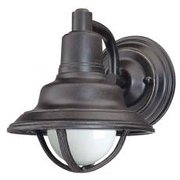|
Home: Marine Outdoor Lighting
What To Look For When Shopping For Marine Outdoor Lighting
These fixtures are competing against water, salt, high winds, and the occasional storms. Salt and water alone would wreck havoc on an ordinary lighting fixture so its best to get it right the first time. Lets look at what makes marine lighting unique enough to measure up to the high standards needed for a marine outdoor environment.
Water Resistance The main purpose of marine lighting fixtures is to keep water from entering into the lamp's housing. The risk of a shortage, or worse, an injury could result if the lamp's housing is not properly insulated. In the United States all lighting fixtures recommended for marine use are designated as such from the National Electrical Code (NEC). The NEC requires that all marine lighting go through thorough testing to ensure that they stand up to the task. These fixtures usually have the fewest number of exposed joints since fewer joints means less chance of water getting into the fixture's housing. Any exposed joints will have a rubber gasket to prevent water from seeping through and wetting any electrical components.
Protective Cage Most marine lights have a protective cage surrounding the fixture's glass lense. The cage is a big help during heavy storms or hurricane strength winds that are likely to blow debree around and damage the fixture's glass lense.
Marine Lighting FinishesTheir constant exposure to moisture and salt means your marine outdoor lighting fixtures must resist rusting. Thats why the metal finishes used in manufacturing these fixtures is either a metal alloy or non rusting metals.
Metal Alloys You'll find that there are many kinds of metal alloys manufacturers use on marine outdoor lighting fixtures. Bronze is a metal alloy containing copper as its base. Bronze outdoor lighting gives your marine fixtures the rust resistant properties they need to withstand the wet and salty marine conditions. Other alloys made of zinc and steel give these fixtures a strong steel base with the rust resistant benefits of zinc. For a more clean look, a stainless steel finish is a great choice. Stainless steel is very strong alloy metal that will not rust. Its also very durable and can take on a harsh outdoor environment.
Non Metal Alloys Some marine fixtures are not alloys but are made up of metals that naturally contain rust resistant properties. One example of this is copper. While copper fixtures will not rust, they will eventually tarnish. Since the marine environment can be extra harsh to a fixture, the copper finish may tarnish a bit sooner than it would under normal conditions. Tarnished copper outdoor lighting fixtures are generally more appealing because of the antique look the tarnishing brings out. As they continue to tarnish, they will eventually change to a blue/green color. The same holds true for brass outdoor lighting fixtures. While brass fixtures also tarnish, their look differs from that of copper. They will begin to darken, giving them a beautifully elegant antique outdoor lighting look. Nickle fixtures are also a great choice for their rust resistant properties. Nickle marine lighting fixtures come in a polished or brushed finish to give you some variety. These fixtures have a more modern design because of their silvery white finish which also doesn't tarnish. If your on the market for marine outdoor lighting fixtures, make sure you choose quality fixtures that can take on the rough marine environment.
|
FREE Newsletter Stay up-to-date with all the latest web updates, news, and outdoor lighting tips! Newsletter Form
|
|
|
|
Always consult with a licensed electrician before attempting any outdoor lighting work contained in this website.
Build your own site with Site Build It! | Copyright©2008 www.Creative-Outdoor-Lighting.com
Get your own custom template
 Marine outdoor lighting must constantly stand up to salty and wet nautical environments, which are thriving conditions for corrosion and rust.
Marine outdoor lighting must constantly stand up to salty and wet nautical environments, which are thriving conditions for corrosion and rust.




